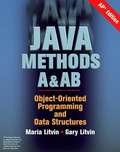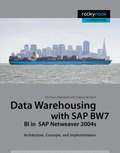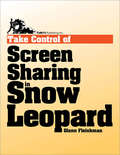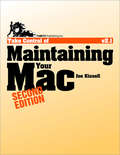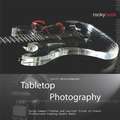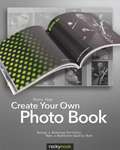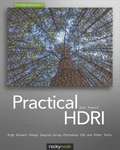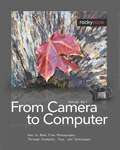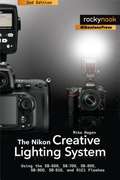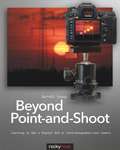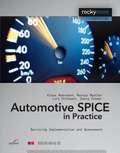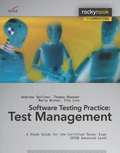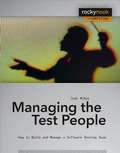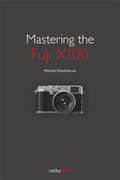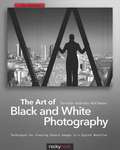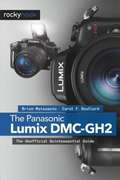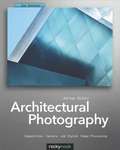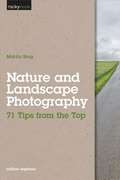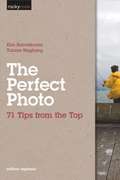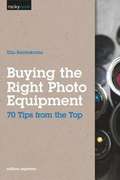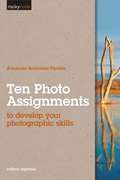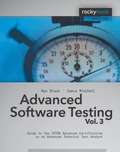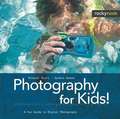- Table View
- List View
Java Methods A & AB: Object-Oriented Programming and Data Structures, AP Edition
by Maria Litvin Gary LitvinIn one volume, this edition covers both introductory Java/OOP A-level material and AB-level topics (data structures and algorithms). The book follows Java 5.0 and incorporates many other changes, big and small, to reflect the current priorities of the AP CS program. This edition offers an early focus on object-oriented programming and design and an expanded discussion of the Java collections framework.
Data Warehousing with SAP BW7 BI in SAP Netweaver 2004s
by Christian Mehrwald Sabine MorlockBI in SAP NetWeaver 2004s is the official abbreviation for the successor of the Business Information Warehouse (BW) which has been completely revised by SAP with its latest release. Core elements of this comprehensive suite for decision making applications are functions for extraction, transformation and data management. With this new release, these functions aim more heavily at company-wide data warehousing. The book focuses on these core tasks of SAP BW and gives well-founded insights into the system architecture. As practical handbook and well-structured reference book, the book is for SAP consultants and IT staff that are responsible for or planning a BW-based data warehouse implementation. Apart from system architecture, the book focuses on detailed descriptions of data management (data models and Analytical Engine) as well as the Staging Engine which have been completely revised and deal with new data transfer process technology. The design of the controlled operations has been substantially expanded and besides a comprehensive description of automization techniques by using process chains, regular maintenance and administration tasks are also discussed (model trimming, technical validation). The book emphasizes a comprehensive view on aspects to manageability and system performance which are discussed in individual chapters but also implicitly in all other ranges of topics.
Take Control of Screen Sharing in Snow Leopard
by Glenn FleishmanInterested in screen sharing, but only with Back to My Mac? This title has the basics about Back to My Mac, but if you want all the details--and oodles of background info and router help--check out Take Control of Back to My Mac. Read this book to learn the answers to questions like: How can I share the screen of a buddy via iChat? What are iChat's screen-sharing limitations? What are the best alternatives? How can I give a presentation remotely using screen sharing? What's the best way to use screen sharing to do remote tech support? What's the best way to control an unattended Mac remotely? How do I share screens with someone running an old version of Mac OS X? How do I share screens with someone running Windows? How do I wake up a remote Mac so I can share its screen? What tricks does Apple employ to make Back to My Mac connections work? How can I copy text from one computer to another while sharing screens? Mac OS X's screen-sharing features aren't sufficient--what third-party software do you recommend?
Take Control of Maintaining Your Mac
by Joe KissellRead this book to learn the answers to questions such as: How can I tell if my Mac is likely to have trouble? How can I find out which unnecessary files are taking up space on my disk? Should I defragment my hard disk and repair permissions regularly? What are the safest ways to clean dust and crud from my Mac? What is the best way to keep my software up to date?
Tabletop Photography
by Cyrill HarnischmacherImagine capturing stunning, professional-looking product shots without needing a studio filled with expensive equipment and large flash units. This book teaches all the steps for creating your own tabletop photography studio. Affordable compact flashes offer a number of creative lighting options within your tabletop studio; and the appropriate lighting and backdrop, and the creative use of your camera's features are key to a perfect image. Author Cyrill Harnischmacher guides you through a variety of exposure and lighting techniques, and covers how to achieve excellent results using compact flash units. Whether you wish to capture product images for use in print or on the web, or you want to improve your photos for personal use, this book will provide you with everything you need to know to get great results. Topics include: Lighting Setups; Reflectors, Diffusors, and Accessories; Soft Boxes and Umbrellas; Strobe Flashes; Combining Long Exposures with Flashlights; Multi-Flash Exposures; Composition and Arrangements; Creating Backdrops; Product Photography; Smoke, Fog, and Special Effects; Food Photography and much more...
Create Your Own Photo Book
by Petra VogtThese days, photographs live on hard drives and DVDs in the company of several thousand other images, coming to light on a computer screen only for a short moment, if ever. In that respect our computer is a one-image-at-a-time exhibition of our photographic work. But as photographers, we like to print our best images, frame and show them at home or at an exhibition, or present a collection of prints in a portfolio. This book will guide you through the process of creating a printed and bound portfolio of your photographs, or even a bookstore-quality coffee table book. Learn about every step of the process, from selecting a book publishing service all the way through designing and proofing your photo book. You'll get practical advice on how to work with software provided by services such as Blurb or Viovio, and will learn about relevant concepts of book design, color management, and digital printing. Create your Own Photo Book is the perfect guide for the aspiring amateur photographer as well as the seasoned pro.
Practical HDRI
by Jack HowardPractical HDRI, 2nd Edition, by pro photographer Jack Howard, leads you into the the new frontier of High Dynamic Range Imaging, a multi-shot technique to digitally capture, store, and edit the full luminosity range of a scene in ways not possible in a single captured image. Fully updated for 2010, the 2nd Edition covers the HDR process from image capture through post-processing for web and print. Practical HDRI, 2nd Edition is richly illustrated with step-by-step tutorials for creating professional results using the leading HDR software titles, including the latest versions of Adobe Photoshop, Photomatix Pro, FDRTools, Dynamic Photo HDR, and HDR PhotoStudio. Howard instructs from experience as a photographer and a writer, with an emphasis on making the HDR process work for you. Topics include: Step-by-step tutorials Basic and advanced workflows and workarounds Web and print optimization File management, keywording Advice on cameras, gear and software HDR imaging can be challenging and frustrating for the uninitiated, as it involves both field and computer expertise. However, Jack Howard explains this complex subject matter in a practical way that will not intimidate the beginner, nor bore the experienced photographer. The emphasis is on the creative process and how to make it work for you-rather than the science behind it.
From Camera to Computer
by George BarrEver wonder what it would be like to get inside the head of an accomplished photographer as he chooses a subject, works the scene, selects an image, and then edits the result into a piece of photographic art? As a follow-up to his successful first book Take Your Photography To The Next Level, author/photographer George Barr now applies the practice to the theory. Go along with George as he searches for subjects, sorts out scenes, refines his composition, and then moves from Camera to Computer to edit his images, not only correcting flaws, but making the images match his vision. You'll see proof sheets and "not quite there" images, and you'll learn tips on image editing from someone who is focused on creating a fine art image rather than mass producing many similar images-often the goal of commercial photographers. With his friendly, easy-to-understand approach George goes beyond how to edit your images by teaching the whys behind the editing process. This book is certain to help you dramatically improve your own images. Topics include: Finding photographic subjects Working the scene Practical issues in composition What to change in a captured image How to edit your images-a practical, easy workflow
The Nikon Creative Lighting System
by Mike HagenMike Hagen opens up a whole new world to those photographers who are already well versed in photography, but may not have a clue about flash photography. With the new and rapidly evolving technology, flash photography (especially advanced light modeling with modern iTTL flash systems) has become an art in itself and should be mastered by all aspiring photographers-amateurs as well as professionals-who are often helpless when it comes to using the full potential of these systems. Using a simple, step-by-step method for setting up and using the newest Nikon iTTL flash units, Mike teaches all the steps required to achieve consistent and amazing flash photos. He solves the common frustrations associated with flash, and specifically teaches how to use the SB-600, SB-700, SB-800, SB-900, SB-910, and R1C1 strobes. Also included is a chapter showing system configuration so readers can duplicate the desired results on their own. Beginning at a basic level and progressing to more advanced techniques, Mike teaches you everything you need to know about mastering Nikon's iTTL flash system.
How to Use Microsoft® Excel® version 1.1
by Joseph M. ManzoHow to Use Microsoft® Office Excel® The Careers in Practice Series V. 1.1 is an textbook appropriate for a course covering Microsoft Excel at a beginner to intermediate level. It is geared toward and will be accommodating for students and instructors with little to no experience in using Microsoft Excel. However, the approach is not at the expense of relevance. How to Use Microsoft® Excel® The Careers in Practice Series approaches Excel from the perspective of making personal and professional quantitative decisions. Personal decisions include big purchases such as homes and automobiles, savings for retirement, and personal budgets. Professional decisions include budgets for managing expenses, merchandise items to markdown or discontinue, and inventory management.
Information Systems: A Manager's Guide to Harnessing Technology version 1.4
by John GallaugherInformation Systems: A Manager’s Guide to Harnessing Technology V 1.4 is intended for use in undergraduate and/or graduate courses in Management Information Systems and Information Technology. Version 1.4 of John's book retains the same structure and theory of the earlier versions, but Version 1.4 updates key statistics and examples, and includes up-to-date case material, such as Pinterest and Facebook’s Instagram acquisition. Adopting version 1.4 guarantees your students will have the most current text on the market, drawing real and applicable lessons from material that will keep your class offerings current and accessible.
Beyond Point-and-Shoot
by Darrell YoungThere are two types of new photographers: those satisfied with their low-cost point-and-shoot cameras, and those more enthusiastic photographers who recognize the limitations of low-cost equipment and want to improve their pictures. No longer satisfied with simple snapshots, the enthusiast moves up to a more complex digital camera-one with interchangeable lenses and manual controls-to satisfy their artistic urge. Assuming little to no knowledge of photographic terms, techniques, or technology, Beyond Point-And-Shoot is intended to help smooth the transition from photographic newbie to "real" photographer who is experienced, in-control, and passionate about their craft. Author Darrell Young explores various types of interchangeable-lens cameras, focusing on those with larger imaging sensors, such as digital single-lens reflex (DSLR) cameras. Learn how to get the most out of your camera's automatic and semi-automatic exposure modes, as well as how to move beyond those modes and take full, manual control of your camera. Watch your photography improve as you discover how to apply important photographic principles, such as depth of field, white balance, and metering. With this newfound knowledge you'll move beyond point-and-shoot and begin taking truly great photographs. Other topics include: Camera types Lenses Aperture, shutter speed, and ISO Metering and shooting controls Lens focal lengths and angles of view The histogram Color spaces Sensors Filters Image file formats Managing digital noise And much more!
Automotive SPICE in Practice
by Klaus Hoermann Markus Mueller Lars Dittmann Joerg ZimmerAutomotive SPICE is a framework for designing and assessing software development processes. If implemented effectively, it leads to better processes and better product quality. It also helps to improve the cooperation among complex supply chains and between globally distributed development and engineering centers. Automotive SPICE has been derived from the ISO/IEC 15504 standard, also known as SPICE. It has been developed under the Automotive SPICE initiative by the consensus of several major car manufacturers such as Audi, BMW, Ford, Fiat, Daimler, Porsche, Volkswagen, and Volvo. Today, Automotive SPICE has become a standard in the international automotive industry. This book is written as a guide to help the reader understand and interpret the requirements of this standard and to implement Automotive SPICE in a real world application environment. It is written for engineers, practitioners, managers, and project managers who need practical guidance in applying or implementing the Automotive SPICE framework in his/her company. Important topics, such as traceability, functional safety (IEC 61508), and the relationship between Automotive SPICE and CMMI are given particular attention. This book is a definite must for practitioners involved in implementing Automotive SPICE in process improvement programs; a welcome aid for any assessor looking for clear, consistent, and constructive rating guidelines; and an invaluable resource for anyone concerned with engineering development processes in the automotive industry.
Software Testing Practice: Test Management
by Andreas Spillner Tilo Linz Thomas Rossner Mario WinterAimed at experts who are dedicated to software testing, The Software Testing Process: Test Management addresses the major issues related to advanced, state-of-the-art test management. This book covers the syllabus required to pass the Certified Tester Examination - Advanced Level as defined by the International Software Testing Qualifications Board (ISTQB). Software developers, project managers, quality managers, and team leaders will benefit from the comprehensive coverage of risk oriented management and the way testing is shown to be an integral, though independent part of software development. Included are best practices in the field of testing, as well as detailed descriptions of involved tasks, roles, and responsibilities. Well suited for self-study, the reader is "taken by the hand" and guided through the key concepts and terminology of software testing in a variety of scenarios and case studies (as featured in the first book in this series, Software Testing Foundations). Not only will testers and test managers find this a must-read, but anyone requiring advanced professional knowledge and skills in this field, anyone wanting to become a true testing professional, will find this book a must for a successful, well-founded education in advanced test management. Topics include: Test process and test tools Testing in the software life cycle Test policy and test manual Test plan and test planning Test control Incident management Risk management/risk-based testing Staff qualifications Test metrics
Managing the Test People
by Judy MckayManaging the Test People was written for managers, leads, and people who may soon find themselves in a technical leadership position. It focuses on some of the unique problems in the software quality assurance profession, yet the bulk of the book is applicable to any technical management job. It provides practical advice for the novice and affirmation for the expert. It contains real world stories illustrating the concepts discussed in the text. This book is written from a practitioner's viewpoint. The author has been in software management for over 20 years, working in a variety of companies, and has always been struck by the lack of practical, real world advice found only in general management books. Yes, all those methods should theoretically work, until you add in the politics of the environment, the technical work that must be done and, of course, those pesky people who seem intent on fouling up your plans. Managing the Test People is real - it's about the real world where there are real problems and real people, and it provides viable solutions that can actually be implemented.
Mastering the Fuji X100
by Michael DiechtierowMastering the Fuji X100 provides the ambitious photographer with everything they need to know to operate this camera that has become an instant classic. Readers will learn about the features and capabilities of the X100 and will discover numerous tips and tricks for how to maximize its potential. Learn how to influence dynamic range, how to optimize focus, which film simulation is best, and much more. The Fuji X100 is a premium digital viewfinder camera that combines compact size with sophisticated technical features and uncompromising optical quality. This unique camera already enjoys cult status and is used by many photographers as the ideal travel and snapshot camera. Nonetheless, the X100 is much more than an automatic snapshot camera--it is a sophisticated photographic tool. In a layout suitable to the camera's attractive design, this manual presents convincing imagery that attests to the fun you will have as you begin to push the envelope of your Fuji X100.
The Art of Black and White Photography
by Torsten Andreas HoffmannOver the last few years, most books on photography have been focused on the new breed of cameras and how to master the digital imaging workflow. In The Art of Black and White Photography author and photographer Torsten Andreas Hoffmann takes a different approach, focusing on image composition and image capture, with an emphasis on the creative aspects of black and white photography rather than on the digital workflow. After introducing the ground rules of composition, Hoffmann illustrates their applications with his own stunning black and white images that cover various photographic genres, including architecture, street photography, portraiture, and surreal photography. Also discussed are the elements of a "photographic language"', which distinguishes creative photography from random shooting. Finally, you will learn valuable post-processing techniques, mostly using Photoshop, that emphasize the functions necessary for creating outstanding black and white images. This second edition has been updated to include Photoshop CS5, as well as brand new images, content, and a revised layout.
The Panasonic Lumix DMC-GH2
by Brian Matsumoto Carol F. RoullardThe Panasonic Lumix DMC-GH2: The Unofficial Quintessential Guide provides a wealth of information and professional insights for owners of this powerful HD camera. With its electronic viewfinder and interchangeable lenses, the GH2 is capable of not only recording professional-quality still images, but has the added ability to record HD video as well. The mirrorless design enhances the camera's versatility beyond that of most digital single lens reflex (DSLR) cameras. With the appropriate adapters, it can use virtually any manufacturer's manual focus, legacy lens. It is smaller than a typical DSLR in both size and weight, and retains automatic focusing while recording videos capability that is missing in many DSLR cameras. With the GH2, Panasonic has significantly expanded the video capabilities beyond those of previous models. Among the improvements is the ability to adjust the frame rate and shutter speed when filming video, giving users greater control over the movie-making process. In this guide, authors Brian Matsumoto and Carol F. Roullard explore and explain the features and capabilities of the GH2 camera in detail, as they cover everything from the basic features of the camera to numerous advanced photographic applications. The informative text is illustrated with example images throughout. Readers will learn how to: Control the most basic camera functions-focus and exposure Navigate the camera's menu system Achieve a range of artistic effects using various camera settings Use the camera's automated controls, and override those controls to obtain better exposure Use the GH2 in its video mode to obtain HD videos Post-process images and videos on a computer Expand the camera's use by mounting it on a telescope or microscope And much more...
Architectural Photography
by Adrian SchulzArchitectural photography is more than simply choosing a subject and pressing the shutter-release button; it's more than just documenting a project. An architectural photograph shows the form and appeal of a building far better than any other medium. With the advent of the digital photographic workflow, architects are discovering exciting new opportunities to present and market their work. But what are the ingredients for a successful architectural photograph? What equipment do you need? How can you improve your images in your digital darkroom? Why does a building look different in reality than in a photographic image? In this book you will find the answers to these questions and much more. Author Adrian Schulz-both an architect and a photographer by training-uses real-world projects to teach you how to: Capture outstanding images of buildings, inside and out Choose the right equipment and use it effectively Compose architectural shots Work with ambient and artificial light Process images in an efficient workflow based on Adobe Photoshop This book is a step-by-step guide to architectural photography for both the aspiring amateur photographer interested in architectural photography and the professional photographer wanting to expand his skills in this domain. Moreover, architects themselves will find this book motivating and inspiring. This second edition has been extensively revised and includes 80 new images and illustrations, as well as an expanded chapter on shooting interior spaces. Also included is an updated discussion of post-processing techniques and the latest technical developments in the world of photography. With this book, you will learn a variety of creative tips, tricks, and guidelines for making the perfect architectural image.
Nature and Landscape Photography
by Martin BorgWhat happens when you bring two of your passions together? Magic, of course. Photography offers a perfect outlet for creativity and emotions. Nature provides peace, serenity, and a wellspring of energy. To combine both--to photograph nature--is a unique and fulfilling experience. In this book, renowned Swedish nature photographer Martin Borg shares his experience and insight along with 71 of his beautiful images that illustrate each point. He offers helpful advice for beginning to intermediate photographers, ranging from technical tips, to aesthetics, to philosophical thoughts on the essence of being a nature photographer.
The Perfect Photo
by Elin Rantakrans Tobias Hagberg"Perfect" is a purely subjective term when it comes to art. A journey toward the perfect photo is a journey without a defined destination. There are photographs that are technically perfect and others that stand out because of their message or composition. Although the perfect photo remains a matter of taste, it is still something every photographer strives for. With this volume, Elin Rantakrans and Tobias Hagberg provide the beginning to intermediate photographer a wide range of practical tips that cover capture, composition, and editing--all with the aim of helping you achieve better photos. Each concept is illustrated with beautiful, inspiring images. Our promise: Use 7 of these 70 tips and you will be a 10% better photographer. Try it!
Buying the Right Photo Equipment
by Elin RantakransWe've all heard the saying, "Clothes make the man"; but does the photographic equipment make the photographer? One might think so when looking at new advanced cameras, dream lenses, and all the editing software out there. Others might disagree after admiring the wonderful photographs by Henri Cartier Bresson or Edward Weston, which were taken with relatively simple cameras and lenses. The real questions to ask yourself are: What kind of images would I like to make? And what are all these things that I see advertised as indispensable photo equipment really for? Geared toward the beginning to intermediate photographer, this book teaches about the variety of photographic tools available and what each is meant to accomplish. Learn about the benefits and drawbacks of various pieces of equipment and discover what kind of gear you need to realize your creative ambitions. The book is filled with beautiful images that illustrate how the type of equipment discussed can affect an image.
Ten Photo Assignments
by Amanda Quintenz-FiedlerBecome a Better Digital Photographer, One Assignment at a Time There is no better way to learn than by doing. While theories, histories, best practices, and sciences ground a thorough knowledge of any subject, at some point you have to apply that information to truly garner knowledge. This book provides real-world assignments that guide prospective photographers to a true understanding and mastery of the craft. Each assignment includes a list of goals, detailed instructions, illustrations, and examples. Individual assignments build on one another, allowing your mastery to grow as the book continues. Learn about the capabilities and limitations of your equipment; the proper ways to expose a scene for digital capture; dos and don'ts of cropping and scene placement; how to color manage a scene in-camera; and how to see, manipulate, and augment light to obtain the best possible native files.
Advanced Software Testing - Vol. 3
by Rex Black Jamie L MitchellThis book is written for the technical test analyst who wants to achieve advanced skills in test analysis, design, and execution. With a hands-on, exercise-rich approach, this book teaches you how to define and carry out the tasks required to put a test strategy into action. Learn how to analyze the system, taking into account the technical aspects and quality characteristics. Additionally, learn how to evaluate system requirements and designs as part of formal and informal reviews, using an understanding of the underlying technology. You will be able to analyze, design, implement, and execute tests, using risk considerations to determine the appropriate effort and priority for tests. You will also learn how to report on testing progress and provide necessary evidence to support your evaluations of system quality. With a quarter-century of software and systems engineering experience, author Rex Black is President of RBCS; is a leader in software, hardware, and systems testing; and is the most prolific author practicing in the field of software testing today. He published several books on testing that sold tens of thousands of copies worldwide. He is President of the International Software Testing Qualifications Board (ISTQB) and is a Director of the American Software Testing Qualifications Board (ASTQB). This book will help you prepare for the ISTQB Advanced Technical Test Analyst exam. Included are sample exam questions, at the appropriate level of difficulty, for most of the learning objectives covered by the ISTQB Advanced Level syllabus. The ISTQB certification program is the leading software tester certification program in the world. With about 100,000 certificate holders and a global presence in 50 countries, you can be confident in the value and international stature that the Advanced Technical Test Analyst certificate can offer you. Related books: Vol. 1: Guide to the ISTQB Advanced Certification as an Advanced Test Analyst (ISBN 978-1-933952-19-2) Vol. 2: Guide to the ISTQB Advanced Certification as an Advanced Test Manager (ISBN 978-1-933952-36-9)
Photography for Kids!
by Sandra Abend Michael EbertDigitization is the biggest advance in the history of photography. While some seasoned photographers may still be wary of the filmless technique, unbiased children have easily found their way into the digital world. Children are excited by the instant gratification of capturing an image and immediately seeing the result. With today's digital cameras, what used to be an expensive and disappointing process is now as easy as pie. Enthusiastic and confident children are able to handle digital cameras with remarkable skill. The instant feedback motivates them to continue exploring, and soon they are able to create small masterpieces full of inspiration and fantasy. Photography for Kids introduces children between the ages of 8 and 14 to the world of photography. Technical concepts--like how a digital camera actually works--are explained in a way that is easy for children to understand. The book emphasizes creativity and presents techniques for capturing exciting images.
